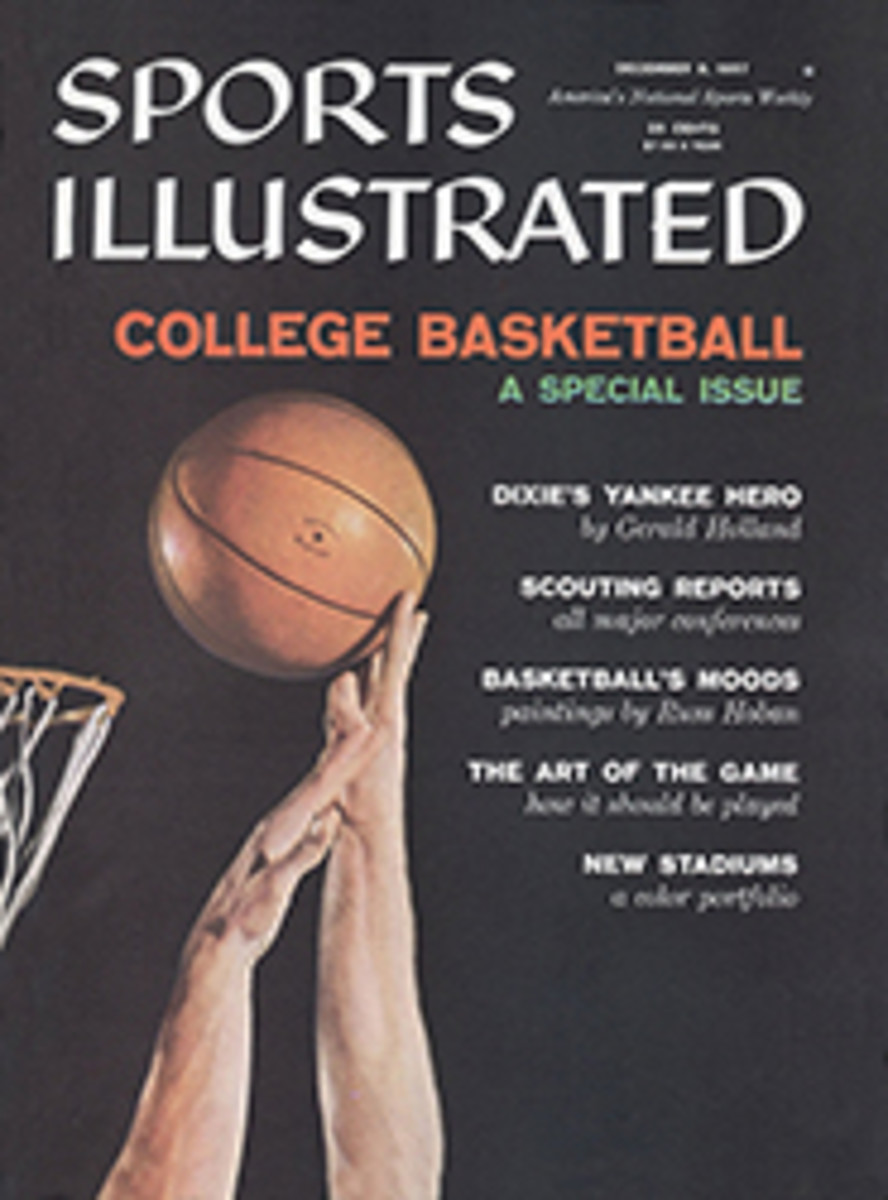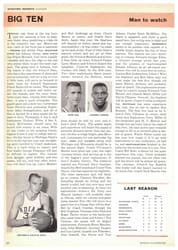
ONE HAND BEHIND HIS BACK
Chauvinistic New Yorkers had gathered early. It was December 29, 1936, the touring Stanford Indians were in town and a lesson was about to be administered. Cutting through the heavy, smoke-laden atmosphere of brilliantly lighted Madison Square Garden, the Long Island University basketball team charged out onto the floor to the accompaniment of a tremendous roar that swept the arena. The champions were ready to operate.
Excitement had been building up for weeks. For the past year reports had filtered across the Rockies from California that this Stanford team was no ordinary group of players. The late city editions of New York papers had dutifully recorded its deeds in short, one-paragraph stories which generally ended with the startling and somewhat cryptic note: "Hank Luisetti, forward, scored 22 points." Nobody playing in those days ever scored 22 points against good competition, much less did it with regularity.
The well-guarded scepticism of New Yorkers was tempered by a natural curiosity. Besides, two nights before, Stanford had beaten a strong Temple team in Philadelphia, with Luisetti scoring 14 points.
The team obviously had something, but it was going to need a lot more than that if it was to stay on the same court with LIU. Over a two-year period, beginning in the middle of the 1934-35 season, Coach Clair Bee's tall, poised Blackbirds had won an unprecedented 43 consecutive games against the best teams in the nation. They were slick ball handlers. They could shoot from the outside to open up their opponents' defenses, and when they had succeeded in doing that they could pass them dizzy under the basket. They were fiery, tenacious defenders.
The game had hardly begun when LIU scored. Stanford tied the score, but an LIU foul shot gave the New Yorkers the lead again. It appeared but a matter of time before another Far West wonder team would meekly fold up against the proved superiority of the East.
Then things began to happen. Stanford, perhaps a bit stage-struck at the outset, settled down and began to play its own brand of basketball which had been only rumored in the East but never seen. The style, it soon turned out, was revolutionary. In pained, partisan disbelief, the crowd of 17,623 watched the metamorphosis of a game. As everybody had always known, the only way to shoot a basketball from the outside was with two hands. Stanford shot with one. Tight control of the ball was the only way to control the outcome of a ball game. You worked the ball around deliberately, passed in and out, waiting, if necessary, as long as two minutes for the one clear shot under the basket. The men from Stanford pushed shots up from the corner, hooked the ball off their ears and, in general, performed with an unorthodoxy that would have got them benched for good had they been eastern players.
But they were Westerners and they were the dedicated prophets of a new style. Led by the tall, dark-haired Angelo Henry (Hank) Luisetti, who ranged all over the court that night, Stanford pulled away steadily to an almost unbelievable 45-31 win. The long reign of LIU was over but, more significantly, so was eastern-style basketball. Modern basketball had come to replace it.
The architect was Luisetti. As great a floor man as he was a shot, he set up most of his team's play with electrifying dribbling and passing. But his real contribution was his shooting. Instead of setting himself for the obligatory two-hander, Luisetti pushed the ball softly toward the basket with one hand while on the run. To everyone's surprise, the ball usually went in. An awed New York Times man wrote: "His shots' would have been deemed foolhardy if attempted by any other player, but with Luisetti heaving, these were accepted by the crowd."
West Coast fans had known all about Hank Luisetti long before he startled the East. As a freshman at Stanford, his one-handed push shot, which he had first used in high school, had developed into a potent scoring weapon. Over one weekend, in two games, Luisetti threw in 70 points, a fantastic total for the mid-'30s. As a sophomore his point total jumped to 416 and he was named to his first of three successive All-America teams. Some experts still consider him one of the great ball handlers of all time. Years before the Cousy era, Luisetti came up with the behind-the-back dribble and used it on occasion when hemmed in by double teaming.
If Luisetti had any weakness as a basketball player, it was a reluctance to shoot more often. One night in his senior year Luisetti's teammates refused to let him pass off. Stanford beat Duquesne 92-27, and Luisetti set a new collegiate scoring record of 50 points. By the time he played his last college game in 1938, Luisetti had totaled more points than any other major college player before him.
Luisetti's fame was so great when he finished at Stanford that he was starred in a movie titled Campus Confessions. Other than Betty Grable's legs, the picture had nothing to recommend it. Indeed, the AAU thought so little of it that a year after it had suspended Luisetti for professionalism it reconsidered and declared him an amateur.
Today, although he never made a name for himself as an actor (he is an automobile salesman in San Francisco), Hank Luisetti's place in basketball history is secure. His scoring records have long since been eclipsed, but today's 100-point team totals derive at least in part from that memorable evening 21 years ago when a talented young man visited Madison Square Garden and turned basketball upside down with, figuratively, one hand tied behind his back.
PHOTO
HARD-DRIVING HANK, one of the game's great dribblers, hustles up court with ball.
THREE PHOTOS
BEHIND-THE-BACK DRIBBLE DEVELOPED BY LUISETTI WAS A COLLEGE SENSATION IN 1935

